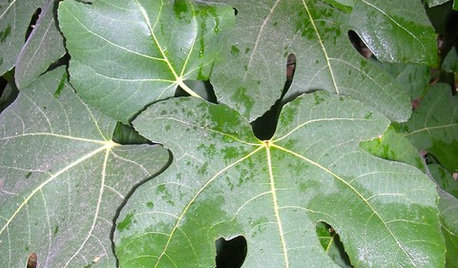What determines the fig tree maturity; the roots or the wood?
ottawan_z5a
15 years ago
Related Stories

GARDENING GUIDESHow to Keep Your Trees Healthy
Ensure your trees’ vigor for years to come with these tips for protecting roots, watering effectively and more
Full Story
HOUSEPLANTSPlay Up Some Fiddleleaf Figs for a Lively Indoor Tune
Strike a dramatic chord in a minimalist scene or a country note in a rustic setting — fiddleleaf fig plants harmonize with any style
Full Story
GARDENING GUIDESGreat Design Plant: Common Fig
A full form and delicious fruits make this Middle Eastern tree a favorite in gardens around the world
Full Story
ARTThe Beauty of Bonsai — Living Art, Rooted in Harmony
Create your own emblem of nature's balance with an art form dating back 1,000 years
Full Story
ARCHITECTURERoots of Style: Do You Live in a Minimalist Traditional House?
Cottages, bungalows, farmhouses ... whatever you call them, houses in this style share several characteristics. See how many your house has
Full Story
REMODELING GUIDESRegional Modern: Metro New York Shows Its Modernist Roots
10 contemporary homes outside Manhattan: Clean lines, rooted in place
Full Story
TREESHow to Use Trees Inside
Bring nature close by integrating the beauty of trunks and trees — even smaller leafy trees — into your home
Full Story
GARDENING GUIDESHow to Keep Your Citrus Trees Well Fed and Healthy
Ripe for some citrus fertilizer know-how? This mini guide will help your lemon, orange and grapefruit trees flourish
Full Story
FALL GARDENING6 Trees You'll Fall For
Don’t put down that spade! Autumn is the perfect time for planting these trees
Full Story
WINTER GARDENINGHow to Help Your Trees Weather a Storm
Seeing trees safely through winter storms means choosing the right species, siting them carefully and paying attention during the tempests
Full StorySponsored



herman2_gw
tapla (mid-Michigan, USDA z5b-6a)
Related Discussions
Transplanting mature fruit trees- root ball size?
Q
Fig Tree- invasive roots, keeping pruned to 5 ft-
Q
Please post pictures of your mature fig trees.
Q
Figs not maturing and falling off
Q
ottawan_z5aOriginal Author
steve_digs
dieseler
steve_nj8
tapla (mid-Michigan, USDA z5b-6a)
arigato
tapla (mid-Michigan, USDA z5b-6a)
steve_nj8
arigato
bradkairdolf
steve_nj8
bradkairdolf
steve_nj8
arigato
steve_nj8
supergeek_3000_yahoo_com
ottawan_z5aOriginal Author
taskk
gorgi
ottawan_z5aOriginal Author
tapla (mid-Michigan, USDA z5b-6a)
taskk
vvenditti_cricketcommunications_com
ccc1
ottawan_z5aOriginal Author
scion
tapla (mid-Michigan, USDA z5b-6a)
scion
tapla (mid-Michigan, USDA z5b-6a)
scion
scion
tapla (mid-Michigan, USDA z5b-6a)
Mac415391